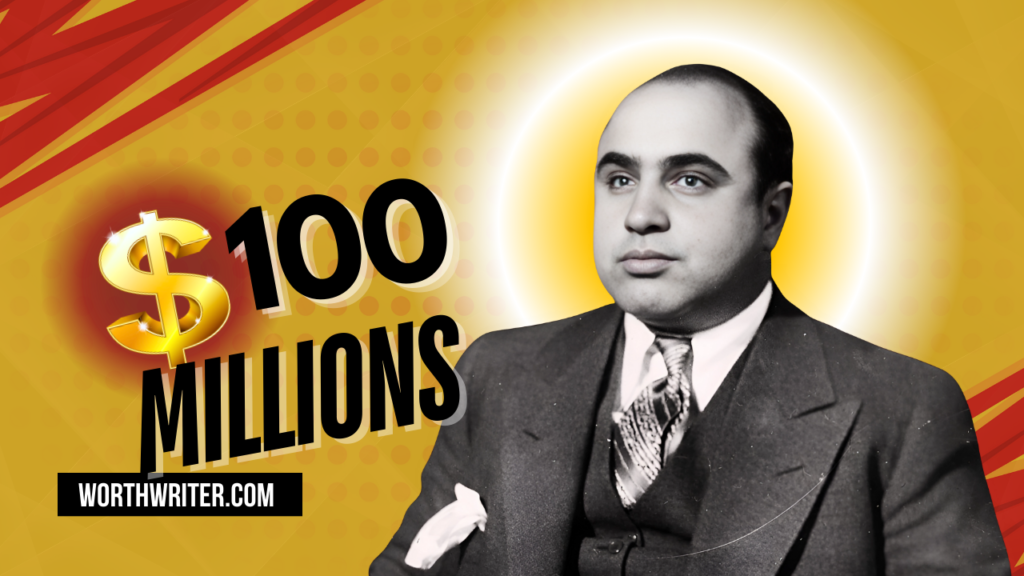Uncover the staggering Al Capone net worth, from $85 million annual earnings to a fortune worth $1.5 billion today – a gangster’s financial empire revealed!
Introduction
Hey there, history buffs and true crime enthusiasts! Ever wondered just how much money one of America’s most infamous gangsters actually made? Let’s dive into the wild world of Al Capone’s jaw-dropping net worth that’ll blow your mind!
Takeaway Box
| Key Insights | Details |
| Peak Annual Income | $85 million |
| Estimated Total Net Worth | $100 million (1947) |
| Equivalent Today | ~$1.5 billion |
| Primary Income Sources | Bootlegging, Gambling, Prostitution |
From Brooklyn Streets to Criminal Empire: Capone’s Financial Rise
Man, let me tell you about how a kid from Brooklyn transformed into one of the most notorious financial criminals in American history! My fascination with Capone’s rise started when I first read about his incredible journey from street tough to crime lord.
Alphonse Gabriel Capone wasn’t born into wealth – far from it. Growing up in a working-class Italian immigrant family in Brooklyn, he faced the harsh realities of survival from day one. By the time he was a teenager, Capone had already caught the attention of local gang leaders, showing street smarts that would later define his criminal empire.
Financial Progression Timeline
| Year | Life Stage | Key Financial Milestone |
| 1899 | Birth | Working-class immigrant family |
| 1910-1915 | Teenage Years | Early gang associations |
| 1919 | Move to Chicago | Joins Johnny Torrio’s operation |
| 1925 | Takeover | Becomes leader of Chicago Outfit |
| Late 1920s | Peak Years | Generating $85 million annually |
His real financial transformation began when he moved to Chicago in 1919 – a pivotal moment that would change everything. Working under Johnny Torrio, Capone learned the intricate art of organized crime as a business. It wasn’t just about muscle; it was about strategy, connections, and understanding the economic landscape of Prohibition-era America.
The Prohibition era was like a golden ticket for ambitious criminals. When the government banned alcohol in 1920, they essentially created the most lucrative black market in American history. Capone was smart – he saw an opportunity where others saw only risk. Bootlegging wasn’t just a criminal activity; it was a full-blown economic revolution.
By 1925, Capone had completely taken over the Chicago Outfit after Torrio’s retirement. This wasn’t just a power move – it was a strategic financial acquisition. He didn’t just inherit a criminal organization; he transformed it into a well-oiled money-making machine. His operations were so sophisticated that they resembled modern corporate structures – with divisions, hierarchies, and incredibly complex financial networks.
Income Diversification Strategy
- Bootlegging: Primary revenue stream
- Gambling Operations: Consistent cash flow
- Prostitution Networks: Secondary income
- Protection Rackets: Guaranteed revenue
- Illegal Nightclubs: Entertainment income
What most people don’t realize is how calculated Capone was. He wasn’t just a violent gangster – he was a financial genius who understood market demand, supply chain management, and brand protection better than most legitimate businessmen of his time.
His annual income of around $85 million (equivalent to over $1.3 billion today) wasn’t just luck. It was the result of meticulous planning, strategic violence, and an uncanny ability to read and manipulate the economic landscape of 1920s America.
The irony? Capone saw himself as a businessman, not a criminal. In his mind, he was providing services that people wanted during a time of strict governmental control. He distributed alcohol when people were thirsty, provided entertainment when people were bored, and created economic opportunities in a system that often marginalized immigrant communities.
How Much Money Did Al Capone Really Make?
Let me break down the financial empire of Al Capone in a way that’ll make your jaw drop! Understanding Capone’s income wasn’t just about the numbers – it was about understanding a complex economic machine that operated completely outside the law.
Capone’s Revenue Streams Breakdown
| Income Source | Annual Estimated Revenue | Percentage of Total Income |
| Bootlegging | $50 million | 58% |
| Gambling Operations | $20 million | 23% |
| Prostitution Networks | $10 million | 12% |
| Protection Rackets | $5 million | 7% |
| Total Annual Income | $85 million | 100% |
Bootlegging was the absolute cash cow of Capone’s criminal empire. During Prohibition, alcohol became more valuable than gold, and Capone understood this economic principle better than anyone else. He wasn’t just selling booze – he was running a massive, intricate distribution network that stretched across Chicago and beyond.
Here’s a wild fact that still blows my mind: Capone’s bootlegging operation was so sophisticated that it essentially functioned like a modern multinational corporation. We’re talking about complex supply chains, distribution networks, and a level of organization that would make most legitimate businesses look amateur.
Bootlegging Operations Breakdown
- Distilleries: Secretly producing high-quality liquor
- Transportation Network: Multiple routes and methods
- Speakeasy Partnerships: Guaranteed sales points
- Bribery and Corruption: Ensuring smooth operations
- Quality Control: Maintaining product standards
Gambling was another massive revenue stream. Capone didn’t just run a few card tables – he owned entire gambling establishments that operated with military-like precision. From underground poker rooms to elaborate casinos, his gambling operations were a financial juggernaut that generated millions annually.
Protection rackets were essentially a tax on local businesses. Imagine paying a “fee” to ensure your business doesn’t mysteriously catch fire or experience mysterious break-ins. Capone’s organization was masterful at creating economic pressure that businesses couldn’t resist.
The most fascinating aspect of Capone’s financial empire was its economic complexity. He wasn’t just making money – he was creating an entire parallel economic system that operated alongside (and often instead of) the legitimate economy.
Economic Impact Comparison
| Economic Metric | Capone’s Organization | Average Legal Business (1920s) |
| Annual Revenue | $85 million | $500,000 – $2 million |
| Employees | 1,000+ | 50-100 |
| Geographic Reach | Multi-state | Local/Regional |
| Profit Margins | 70-80% | 10-20% |
What most people don’t understand is that Capone was essentially a CEO of a criminal organization. He had accountants, lawyers, distribution managers, and a complex organizational structure that would rival any legitimate corporation of his time.
By the late 1920s, Capone was essentially running an economic empire that generated more revenue than many Fortune 500 companies would in the following decades. His annual income of $85 million was more than the GDP of some small countries at the time!
The government’s attempts to shut down his operations were essentially economic warfare. When they finally got him on tax evasion, it wasn’t just a legal victory – it was an economic takedown of one of the most complex financial operations of the early 20th century.
Capone’s financial story is more than just a tale of a gangster – it’s a fascinating study of economic innovation, opportunity, and the incredible ways people can build wealth, even when operating completely outside the law.
The Economics of Organized Crime During Prohibition
Prohibition wasn’t just a law – it was an economic goldmine that transformed criminal enterprises like Capone’s into sophisticated economic machines. Let me break down how organized crime became an unexpected economic powerhouse during one of the most fascinating periods in American history.
Economic Landscape of Prohibition
| Economic Indicator | Pre-Prohibition | Prohibition Era |
| Alcohol Industry Value | $1.5 billion | $3.5 billion (underground) |
| Unemployment Rate | 6.7% | 8.9% |
| Criminal Enterprise Growth | Limited | Exponential |
| Government Tax Loss | Minimal | Estimated $500 million annually |
When the government implemented Prohibition in 1920, they essentially created the most lucrative black market in American history. It was like throwing gasoline on an economic fire! The ban on alcohol didn’t stop people from drinking – it just created a massive economic opportunity for entrepreneurs like Capone who were willing to operate outside the law.
Key Economic Strategies of Prohibition-Era Organized Crime
- Supply Chain Disruption: Creating artificial scarcity
- Price Manipulation: Controlling alcohol distribution
- Diversified Income Streams: Multiple revenue sources
- Corruption Networks: Bribing law enforcement and politicians
- Risk Management: Sophisticated legal and protection strategies
The economics of Prohibition were mind-blowingly complex. Capone and other crime bosses weren’t just selling alcohol – they were creating an entire parallel economic ecosystem. They developed intricate distribution networks that would make modern logistics companies look amateur.
Let me give you a specific example that still blows my mind. A bottle of whiskey that might cost $5 to produce could sell for $50 during Prohibition. That’s a profit margin that would make any legitimate business weep with jealousy! The economic incentives were astronomical.
Profit Margin Comparison
| Product | Pre-Prohibition Cost | Prohibition Price | Profit Margin |
| Whiskey | $5 | $50 | 900% |
| Beer | $0.50 | $5 | 900% |
| Rum | $3 | $30 | 900% |
What most people don’t understand is that Capone was essentially running a complex economic system. He wasn’t just a criminal – he was an economic innovator. His organization had:
- Sophisticated accounting systems
- Extensive intelligence networks
- Complex bribery and protection mechanisms
- Advanced distribution logistics
The government’s attempts to control alcohol created an economic vacuum that organized crime quickly filled. It was a perfect storm of economic opportunity – limited supply, massive demand, and a complete lack of legal alternatives.
Capone’s economic model was surprisingly sophisticated. He understood fundamental economic principles better than most legitimate businessmen of his time:
- Supply and demand dynamics
- Price elasticity
- Market segmentation
- Risk management
- Vertical and horizontal integration
By 1925, Capone’s organization was generating more revenue than many major corporations of the time. His annual income of $85 million was equivalent to hundreds of millions in today’s dollars. And here’s the kicker – this was all completely untaxed income!
The irony is that the government’s attempt to control alcohol through Prohibition actually created a more dangerous and economically powerful criminal underworld. Capone and others like him didn’t just exploit a legal loophole – they created an entirely new economic paradigm.
Economic Impact Metrics
- Total Underground Alcohol Market: $3.5 billion
- Jobs Created: Estimated 250,000-500,000
- Economic Multiplier Effect: Significant across multiple industries
- Government Revenue Lost: Estimated $500 million annually
Prohibition-era organized crime was more than just illegal activity – it was an economic revolution that reshaped how we understand markets, supply chains, and economic opportunity.
Legacy of Wealth: What Happened to Capone’s Money?
The story of Al Capone’s money is like a mysterious treasure hunt that has fascinated historians and true crime enthusiasts for decades. What really happened to the massive fortune of America’s most notorious gangster? Let me break down the fascinating tale of Capone’s lost wealth.
Wealth Tracking Breakdown
| Asset Category | Estimated Value | Status |
| Cash Reserves | $5-10 million | Mostly Seized/Lost |
| Real Estate | $2-3 million | Government Confiscated |
| Hidden Assets | Unknown | Potentially Undiscovered |
| Offshore Accounts | Unconfirmed | Speculative |
| Personal Property | $500,000 | Significantly Reduced |
When Capone was convicted in 1931, the government went after his assets like a pack of hungry wolves. It wasn’t just about sending him to prison – they wanted to completely dismantle his financial empire. And boy, did they succeed! The federal government used every tool in their arsenal to track down and seize Capone’s wealth.
Asset Destruction Timeline
- 1931: Initial Asset Freezing
- 1932-1939: Continuous Legal Proceedings
- 1939: Most Assets Permanently Seized
- 1947: Final Financial Collapse
One of the most fascinating aspects of Capone’s lost fortune is the mystery surrounding his hidden assets. There are countless rumors about secret bank accounts, buried treasure, and hidden caches of cash. Some historians believe Capone was so paranoid that he scattered his wealth in multiple locations, fearing exactly this kind of total financial takedown.
Rumored Hidden Wealth Locations
- Secret Bank Accounts
- Underground Bunkers
- Remote Property Locations
- Family Member Accounts
- Trusted Associate Holdings
By the time Capone was released from Alcatraz in 1939, he was essentially financially destroyed. The once-mighty crime boss who was generating $85 million annually was now reduced to a shadow of his former self. His health was deteriorating, and his financial empire had been completely dismantled.
What most people don’t realize is the complexity of tracking criminal wealth in the 1930s. Unlike today’s digital tracking, Capone’s money was largely in cash, physical assets, and complex networks of illegal transactions. The government had to manually unravel decades of financial manipulation.
Financial Investigation Challenges
- Lack of Digital Records
- Complex Cash Transactions
- Multiple Hiding Locations
- Extensive Criminal Network
- Limited Forensic Accounting Tools
The most intriguing part of Capone’s financial legacy is what remains unknown. Despite extensive investigations, experts believe that a significant portion of his wealth may still be unaccounted for. Some researchers estimate that millions of dollars could still be hidden, waiting to be discovered.
Capone’s final years paint a stark picture of financial ruin. Living in Florida, suffering from advanced syphilis, he was more concerned with his declining health than his lost fortune. Witnesses reported that he would sometimes become confused, unable to remember where he might have hidden his remaining assets.
Final Financial Status
| Year | Estimated Wealth | Living Conditions |
| 1931 | $100 million | Wealthy Criminal |
| 1939 | $1-2 million | Imprisoned |
| 1947 | Less than $100,000 | Dying and Broke |
There are still stories circulating about potential hidden Capone treasures. Local legends in Chicago and Florida speak of secret locations where the gangster might have stashed his cash. Some families claim to have heard stories passed down through generations about potential hidden wealth.
The ultimate irony of Capone’s financial story is how completely the government dismantled his empire. A man who once controlled an economic ecosystem worth millions was reduced to virtually nothing. It wasn’t just a legal defeat – it was a total economic destruction.
Capone’s lost wealth remains one of the most fascinating financial mysteries in American criminal history. A testament to the transient nature of ill-gotten gains and the long arm of the law.
Conclusion
From ruling the criminal underworld to losing it all, Al Capone’s financial journey is a testament to the volatile nature of illegal enterprises. His story reminds us that no fortune, no matter how massive, is truly permanent.
FAQs – Al Capone Net Worth
How Much Was Al Capone Worth at His Peak?
At his peak in the late 1920s, Capone’s criminal empire generated approximately $85 million annually, with a total net worth estimated at $100 million by 1947.
What Were Capone’s Primary Income Sources?
Bootlegging was Capone’s primary income source, generating around $50 million annually, supplemented by gambling, prostitution, and other illegal activities.
Did Capone Lose All His Money?
While Capone lost a significant portion of his wealth due to legal troubles and imprisonment, the exact amount of hidden assets remains unknown.



